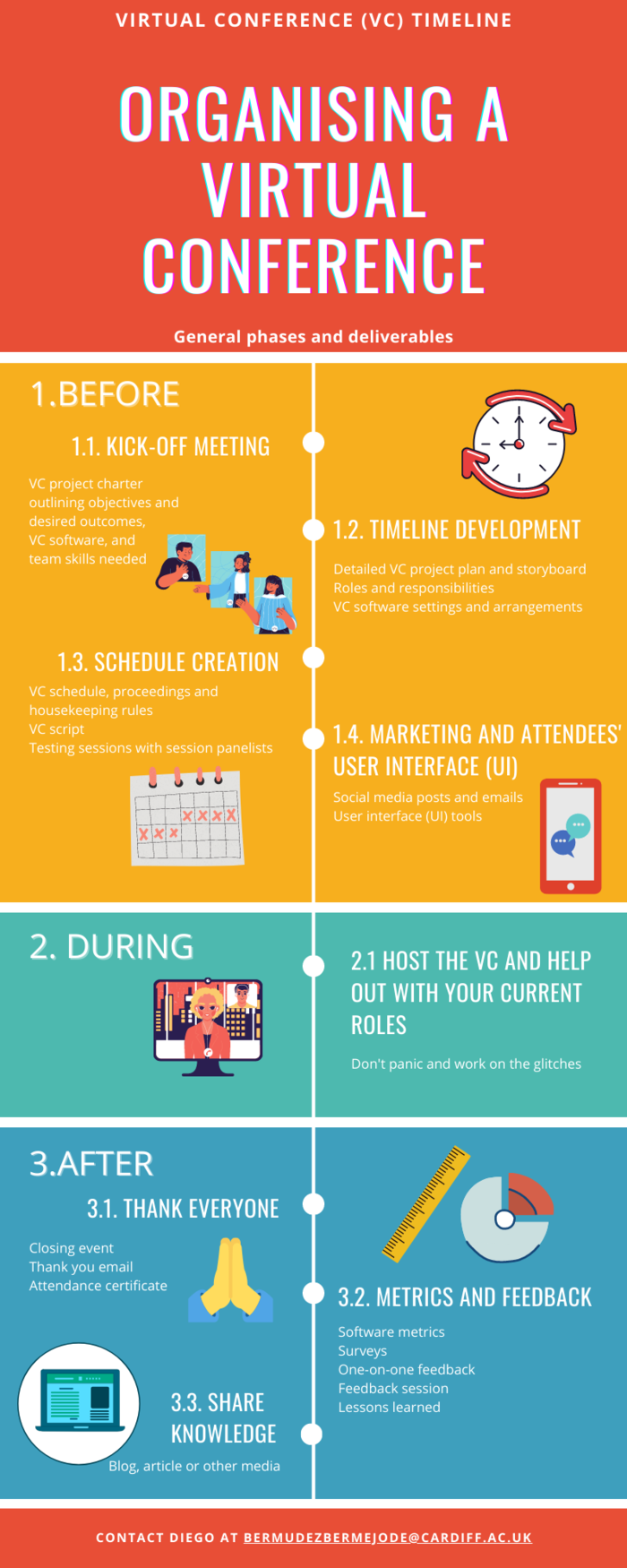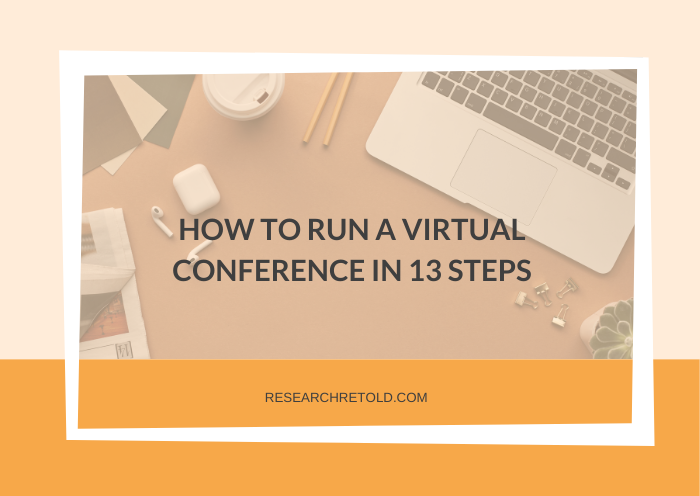To discuss how to run an engaging virtual conference, we’re collaborating with Diego Bermudez, a PhD student at Cardiff University.
Diego’s research focuses on developing resiliency and sustainability in payment technologies, and he is based at the Cardiff Business School. He attended our ‘Collaborating with industry for social impact and research’ workshop following which we agreed to collaborate on a blog about how to run an engaging virtual conference.
Diego has a wealth of experience and is keen to share this will fellow researchers who might be in a similar situation.
![]()
Knowing how to run a virtual conference – a must during the COVID-19 pandemic
Most research students and professors must adapt to continue research and teaching during the COVID-19 pandemic. One of the biggest challenges has been the rapid and unprecedented transition from traditional face-to-face conferences to virtual events.
Most conferences that were scheduled to take place in 2020/2021 were cancelled, along with other mass gathering events. This situation was understandably frustrating for many since the opportunities to travel to other places, present our work, and receive feedback, suddenly disappeared. Undeterred, many conference chairs and organising committees took up the challenge of delivering a virtual conference.
In this blog post I share the step by step process for how to run an engaging virtual conference: before, during, and after. I hope this will be helpful in your own journey to run a virtual conference (VC).
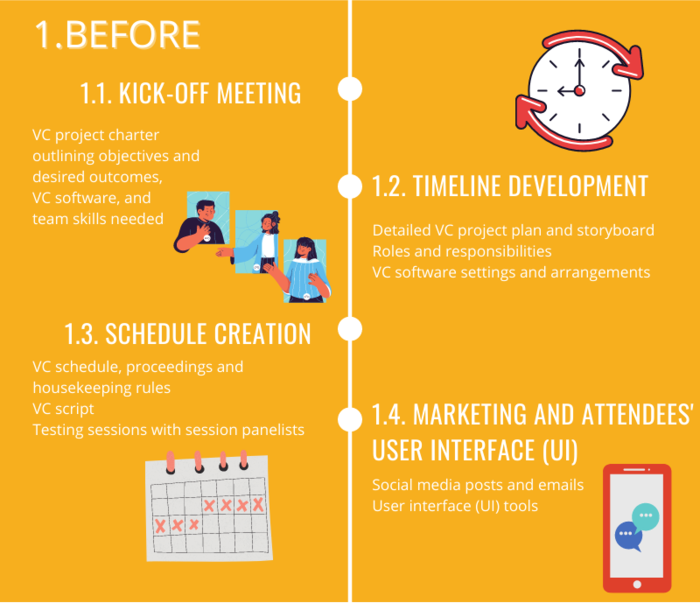
1. Before the conference
1.1. Kick-off meeting
1.1.1. Determine the objectives and desired outcomes
In the current context, it all comes down to a topic, like “How to (place your topic) in a pandemic”. It is always important to determine what your desired outcomes are and if they are SMART objectives that would be ideal. The aim is to align your content with your outcomes.
1.1.2. Identify the software and team skills needed
Whether you are a techie or not it is possible to set up a virtual conference. You can start by reading tech reviews and setting up some trials with software providers. There might be different needs according to the audience and content. Also, define the different roles needed to run the virtual conference, including the chair(s), panellists, and technical support.
1.1.3. Set the team and review the conference project charter
You could hold separate meetings to set up the virtual conference organising team and to review the overall conference project charter. If you need some help with ideas, just google “project charter template”.
1.2. Activity timeline development
1.2.1. Build a detailed project plan
Set out the different activities and deliverables for the virtual conference along with dates, deadlines, and the person(s) responsible for the activities. It can be helpful to create a storyboard for the entire virtual conference journey.
1.2.2. Divide the activities according to the time available
If this is the first time you are running a virtual conference, allow enough time to develop the activities. Consider the delays in response time that come with not being close physically. Staying responsive is important, so be sure to establish update meetings frequently.
1.2.3. Select and set the software arrangements
Once you have selected the software according to your needs, run trials to understand the capabilities you will need to run the conference, such as installing the software on different operating systems, recording sessions, sharing documents and other useful features.
1.3. Create the schedule
1.3.1. Build the schedule, proceedings, and housekeeping rules
You decide what the conference content will be, from presentations, roundtables, and discussion groups, all in a virtual setting. Establish some guidelines, write them down and always remind people at the beginning of each session.
1.3.2. Write down the script
It is important to visualise what should ideally take place in each session, as well as outline the roles and lines of the people participating. People get nervous, technology fails, and it is better to handle things that are in your control – the session chairs will thank you. Also, here you may run into technical issues, so the technical actions should be outlined as well.
1.3.3. Host testing sessions with each presenting panel
Practice makes perfect. Although people may be used to some technical issues, it is a good idea to solve as many issues as you can beforehand. Make sure that the panellists have a chance to practice their session, including any interactive elements such as sharing a video, asking people to download software or opening a webpage. It is a good idea to have a plan B or even plan C in case things do not go as planned. IMPORTANT: Make sure to obtain panellists’ consent to record and share documents with the audience.
1.4. Marketing and attendees’ User Interface (UI)
1.4.1. Publicise the virtual conference
With many events running, it is important to publicise your virtual conference widely. Social media can be very helpful for this, so it is key to ensure that you develop impactful content and graphics, and identify influential people or forums where targeted recurrent posts can create more engagement. In my experience, the most influential social media networks for publicising virtual conferences are LinkedIn, Twitter, Facebook, and Instagram. Each of these platforms can help you track user engagement. Google Analytics is another helpful engagement tracking tool.
1.4.2. Build the UI tools
From the conference’s proceedings to the etiquette guidelines, you have to imagine the whole virtual conference journey. From setting up the registration site, and sending reminders about sessions, to having all the presentations available on the virtual conference site, and setting up a virtual networking environment.
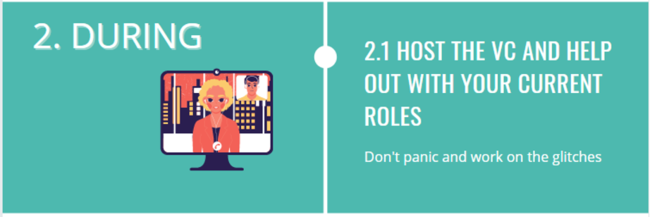
2. During the conference
2.1. Host the conference and help with your current roles
It goes without saying that delivery is the most important part of how to run an engaging virtual conference. But issues and glitches can occur. Don’t panic if these glitches appear, instead try to follow the scripts and work through them with the virtual conference technical team to find a solution. If you are an attendee, be patient and understanding.
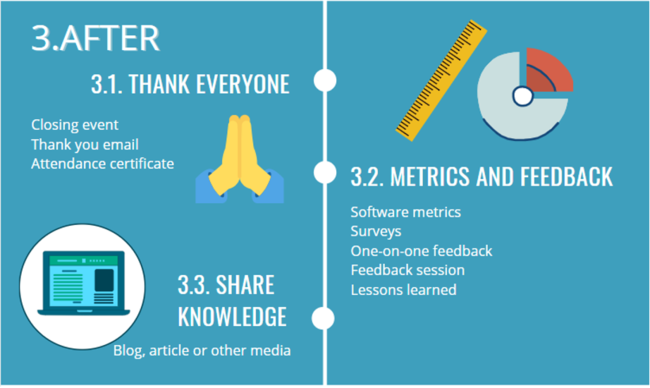
3. After the conference
3.1. Thank everyone!
Remember to thank the attendees and the people that made the conference possible. You could send a thank you email to all the attendees, in which you can include the links to the resources, feedback form and an attendance certificate.
3.2. Obtain metrics to analyse and feedback lessons learned to the organisers
Host a thank you session with all those who organised the virtual conference.
Celebrate the outcomes, and reflect on the event. One of the perks of the digital environment is that you can capture metrics to assess engagement.
Documenting the lessons learned and passing them on will help to improve things for future online events.
3.3. Share the knowledge with your peers
I hope you found this blog helpful, and whether you are organising or attending a virtual conference, you should hopefully now be more prepared.
Let us know your experiences and questions in the comments below!
Many thanks to Diego for sharing his insights with us on how to run an engaging virtual conference and for putting together this handy infographic summary:
